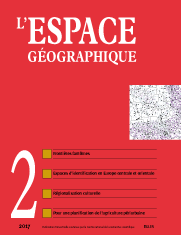

Lessons from phantom borders: Traces from the past (also) come from the future (1 fig.)
The heuristic interest of the concept of “phantom borders” in the understanding of cultural regionalisation (1 fig.)
The concept of “phantom borders” offers a theoretical answer to a series of specific, empirical enigmas in Central and Eastern Europe. The individual cases addressed by this concept are heuristically rich in possible answers to the question of the long-term production and differences in neighboring societies. It also contributes to a more general analysis of the phenomena of geographic differentiation and regionalization at a scale that the latest developments in cultural geography notoriously tend to neglect and even reject.
keywords: DECONSTRUCTIVISM, EUROPE, CULTURAL GEOGRAPHY, GEO-HISTORY, GEOGRAPHICAL IMAGINATION, STRUCTURE
Phantom borders and ambivalent spaces of identification in Ukraine (3 fig.; 8 photos)
Our contribution, rooted in cultural geography, examines the highly topical issue of Ukraine’s internal divisions. Journalists, scholars, and political players readily divide Ukraine into various cultural regions whose boundaries often recycle/retrace former imperial or national borders. These interpretations/readings/ decisions/play off the similarity between certain electoral, linguistic, and politic maps. By studying the symbols and monuments in two villages on opposite sides of a historical border in western Ukraine, we question these univocal interpretations and shed light on the ambivalence of spaces of identification and the ties these village communities entertain with history.
keywords: PHANTOM BORDER, CULTURAL GEOGRAPHY, CULTURAL IDENTIFICATION, SYMBOL, UKRAINE
Summoning historical phantoms. Invention of memorial sites and reification of territorial identities in the Romanian Carpaths (3 fig.; 3 photos)
Beginning in 2008 and over the span of a few short years, Ghimeș – in the upper Trotuș valley, in the Eastern Carpathians of Romania – became a center for Hungarian national fervor. This article retraces how local and foreign actors, within the limited territory of the Csángós minority, summon “historical phantoms”. It shows how the affirmation of identity has combined with economic opportunism in the invention of a memorial site dedicated to the “Thousand year” border. It also analyses the effects of the competition of symbols on the reification and dualization of cultural and territorial identities.
keywords: CSÁNGÓS, MEMORY, MINORITY, PHANTOM BORDER, SICULE, TOURISM
Berlin beyond the breaks. Living, telling and producing the material of the city (2 encadrés; 2 fig.; 4 photos)
Despite the reunification nearly a generation ago, traces of the former division remain sensitive in Berlin. This article examines the vernacular and daily modality of the modernization of this past. It analyses the concrete processes by which ordinary actors erase certain, inherited urban forms or on the contrary restore others. The concept of “phantom borders” allows us to articulate three time frames: the physical and social temporality of the city built and rebuilt on itself; the temporalities of the imagination that are continuously reevaluated and which give meaning to urban space; the temporality of the experience of inhabitants and passerbys who use the city.
keywords: IMAGINATION, PHANTOM BORDER, EXPERIENCE, PLACE, WALL, TEMPORALITY
A systemic methodology to characterize peri-urban agriculture for the better integration of agricultural stakes in urban planning (2 encadrés; 5 fig.)
Community concerns about peri-urban agriculture legitimate its protection in planning. However, existing planning tools hardly take into account the specificities of agriculture as an economic activity requiring facilities that are not necessarily related to urban vision of farming spaces. Looking for supporting the integration of peri-urban agriculture in urban planning, we propose a methodological framework to characterize homogenous spatial units of peri-urban agriculture (USAPU) enabling to make an assessment adapted to planners’ constraints. Our approach seeks to be a tool to steer public action toward areas where it will be most efficient for developing a territorial project.
keywords: METHODOLOGY, PERIURBAN AGRICULTURE, AVIGNON, PUBLIC ACTION, URBAN PLANNING
Book reviews
In this issue of l’Espace géographique, you will find critical reviews of the following books
Denis M. (2016). Petit traité de l’espace. Un parcours pluridisciplinaire. Bruxelles: Éditions Mardaga, 324 p. (Denise Pumain, université Paris 1 Panthéon-Sorbonne) ISBN: 978-2-8047-0322-6
L’espace géographique 1/17![]()
![]() L’espace géographique 3/17
L’espace géographique 3/17
For subscribe or buy this issue: BELIN
![]() L’Espace géographique: contents
L’Espace géographique: contents
Last modified: June 3, 2017